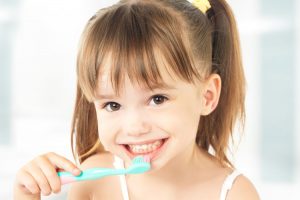HOME CARE RECOMMENDATIONS / NUTRITION & ORAL HEALTH / BABY BOTTLE TOOTH DECAY / FLUORIDE / SEALANTS
HOME CARE RECOMMENDATIONS
A healthy smile begins when the first teeth come into the mouth. Establishing good oral habits at a young age will set your child up for success. The habits that are established in childhood will carry into adulthood.
Brushing and flossing are important because the bacteria (i.e., sugar bugs) that live in everyone’s mouth, which we cannot completely get rid of, multiply very quickly. Since we can’t eradicate the bacteria completely, it is vital to keep the bacterial count low enough that they cannot produce sufficient quantities of acid to cause cavities. The best way to reduce their numbers is to “knock ’em off” our teeth through effective brushing and flossing habits.
At South Hills Pediatric Dentistry, we recommend:
1. Adult Supervision until AT LEAST age 7-8:
2. Brush two times a day:
3. Floss once a day:
4. Fluoride:
Fluoride Mouth rinse is appropriate for children who are able to swish and spit. The fluoride is incorporated into the tooth structure to make the tooth more resistant to acids and cavitation.
NUTRITION AND ORAL HEALTH
Establishing good nutritional habits for your child can be especially beneficial to promote good eating patterns and food choices for the rest of his or her life. Think of your child’s mouth as the doorway to the rest of the body. Whatever gets consumed not only affects your child’s growth, development, weight, and energy levels, but oral health as well. Eating a nutritious, balanced diet is vital for the development of strong, healthy teeth.
General Tips for a Healthy Diet and a Healthy Mouth
- Limit your child’s consumption of sugary foods and beverages. When plaque combines with the sugars and starches, an acid is produced that attacks enamel on the teeth, and eventually causes decay.
- Make sure your child’s diet includes a balance of fruits and vegetables, whole grains, protein, and dairy products. The nutrients found in these foods are essential to his or her growth and health.
- Look for sugar in unexpected places. Many foods that make up a balanced, healthy diet contain sugar – including fruit, some vegetables, and milk. The best time to eat these is during meal time, not as a snack.
- Speaking of snacks, limit your child’s snacking to only a few per day, and make sure they’re nutritious!
- Fun foods, like candy and starchy snacks, should be reserved for special occasions, not everyday snacking.
- When he or she is old enough, let your child chew sugar-free gum that carries the ADA seal. Chewing sugar-free gum increases saliva flow, which washes away food debris and neutralizes acids produced by bacteria.
- Ensure your child brushes twice a day and flosses to eliminate food debris that lead to harmful plaque and bacteria, and causes tooth decay.
BABY BOTTLE TOOTH DECAY
Also known as early childhood caries, baby bottle tooth decay refers to tooth decay in infants and toddlers. Your child needs strong, healthy primary teeth to properly chew food and learn to speak, so preventing baby bottle tooth decay is very important.
The Causes of Tooth Decay in Children
There are many risk factors when it comes to children’s tooth decay. A common cause is the frequent and prolonged exposure of your little one’s teeth to sugary drinks, including milk, formula, and fruit juice. Giving your child a sugary drink at nap or night-time can be especially harmful, because the flow of saliva decreases during sleep. Bacteria in the mouth thrive on sugar and produce acids that attack the teeth.
Tooth decay can also be caused by bacteria passed from you to your baby through saliva by sharing spoons, testing foods before feeding them to your baby, and cleaning off a pacifier in your mouth instead of with water. These germs can start the process that causes cavities even before your baby’s primary teeth emerge, so it’s worthwhile to avoid sharing saliva with your baby from the start.
If your infant or toddler does not receive an adequate amount of fluoride internally through water, especially if he or she drinks bottled water, there can also be an increased risk for tooth decay. Your pediatric dentist may prescribe fluoride supplements to help prevent tooth decay.
Tooth Decay Prevention
The good news about baby bottle tooth decay is that it’s preventable!
- Wipe your baby’s gums with a clean gauze pad or washcloth after each feeding.
- Begin brushing your child’s teeth when the first tooth comes in.
- Clean and massage gums in areas without teeth.
- NEVER put liquids like Koolaid, juice, or soft drinks in your child’s bottle.
- NEVER allow your child to fall asleep with a bottle that contains anything but water.
- The last thing in your child’s mouth at bedtime should be a toothbrush.
- NEVER dip a pacifier in anything sweet, like sugar water or honey.
- Schedule an appointment with your pediatric dentist by your child’s first birthday or when the first teeth begin to emerge.
- Remember, healthy little smiles grow up to be healthy big smiles!
FLUORIDE
Your child brushes his/her teeth twice a day, flosses regularly, and visits the dentist every six months. But did you know that rinsing with fluoride — a mineral that helps prevent cavities and tooth decay — also helps keep his/her teeth healthy and strong?
Fluoride is effective in preventing cavities and tooth decay by making enamel more resistant to acid and preventing plaque from building up on the tooth’s surface.
Fluoride comes in two varieties, systemic and topical:
- Systemic fluoride is ingested, usually through a public water supply. While teeth are forming under the gums, the fluoride strengthens tooth enamel, making it stronger and more resistant to cavities.
- Fluoride can also be applied topically to help prevent caries (cavities) on teeth present in the mouth. It is delivered through toothpaste, mouthwash, or professional fluoride applications. Professional application of topical fluoride varnishes is a valuable tool in cavity prevention.
Receiving Fluoride Treatment from a Dentist
A fluoride treatment in the dentist’s office takes just a few minutes. After the treatment, patients are asked to not eat or drink anything hot or crunchy for at least 3 hours in order to allow the teeth adequate time to absorb the fluoride. Depending on your son or daughter’s oral health or your doctor’s recommendation, your child may be required to have a fluoride treatment every three, six, or 12 months. We may also prescribe at-home fluoride products such as mouthwash, gels, or antibacterial rinses.
Choosing the Right Fluoride Treatment
When choosing an at-home fluoride product (such as toothpaste or mouthwash), always check for the American Dental Association (ADA) seal of acceptance. Products marked with the ADA seal of approval have been carefully examined and approved by the ADA based on safety and effectiveness. Generic brands that have the same active ingredients as brand name products are also acceptable and are more affordable.
SEALANTS
Sometimes brushing is not enough, especially when it comes to those hard-to-reach spots in your child’s mouth. It is difficult for a toothbrush to reach between the small cracks and grooves on teeth. If left alone, those tiny areas can develop tooth decay. Sealants give your child’s teeth extra protection against decay and help prevent cavities.
Dental sealants are plastic resins that bond and harden in the deep grooves on the tooth’s surface. When a tooth is sealed, the tiny grooves become smooth, and are less likely to harbor plaque. With sealants, brushing becomes easier and more effective against tooth decay.
Sealants are typically applied to children’s teeth after their permanent teeth have erupted as a preventive measure against tooth decay. It is more common to seal “permanent” teeth rather than “baby” teeth, but every patient has unique needs, and our pediatric dentists will recommend sealants on a case-by-case basis.
Sealants last from three to five years, although it is fairly common to see adults with sealants still intact from childhood. A dental sealant only provides protection when it is fully intact so if your child’s sealant comes off your child’s dentist may recommend a retouch.






